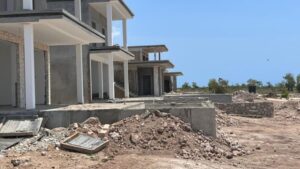The only telecommunication company operating in Tanzania listed on the Dar es Salaam Stock Exchange (DSE) reported Sh507.991 billion in revenues during the period, up from Sh484.981 billion that was registered during a similar period last year.
While M-Pesa remains the major source of money amid a sustained decline in income from mobile voice, it is actually data that has emerged as the fastest growing revenue-generating stream for Vodacom during the period under review.
Mobile data revenue increased 29.9 percent to Sh125.9 billion.
This puts data as the third highest source of revenue for Vodacom Tanzania, contributing 24.8 percent of service revenue, the company’s interim condensed consolidated financial results for the period ended 30 September 2022, shows. At Sh169.6 billion and Sh143.8 billion, M-Pesa and mobile voice remain the first and second highest sources revenue for Vodacom Tanzania respectively.
This, according to the financial results, was due to 28.3 percent improvement in the average amount that subscribers spent on data (Average Revenue Per User – ARPU) during the period.
“….this reflects strong demand for data services as a result of our continued investment into the network and acceleration of smartphone adoption,” the company says in its financial statement, adding that during the period, monthly average usage per customer grew 28.6 percent to 2.0 gigabyte.
Similarly, smartphone users on Vodacom’s network grew 18.2 percent to 4.7 million representing 58.8 percent penetration to data customer base, thanks primarily to the firm’s commercial initiatives in driving smartphone adoption and conversion, including investment in device subsidy and expanding our share of open market device sales.
While M-Pesa is also seen to be on the recovery, the company says, the rise in revenue was also partly supported by another double-digit growth in revenue from fixed services.
“The decision by the government to review levies on mobile money transfer and withdrawal transactions introduced on 15 July 2021, is a welcome move. The reduction is particularly relevant to our peer-to-peer and cash-out transactions which posted a modest recovery in the second quarter and our ability to expand financial inclusion to more Tanzanians,” Vodacom Tanzania’s managing director, Mr Philip Besiimire, said.
M-Pesa customers recovered to 7.7 million, up 19.5 percent.
Share this news
This Year’s Most Read News Stories

Shock waves hit Zanzibar’s Real Estate industry
The revocation of British developer Pennyroyal’s leasehold for the construction of Blue Amber Resort by the Revolutionary Government of Zanzibar has sent shock waves in the nascent property market on the Isles.Continue Reading

Tanzania Declares End of Marburg Virus Disease Outbreak

Tanzania today declared the end of Marburg virus disease outbreak after recording no new cases over 42 days since the death of the last confirmed case on 28 January 2025.
The outbreak, in which two confirmed and eight probable cases were recorded (all deceased), was the second the country has experienced. Both this outbreak, which was declared on 20 January 2025, and the one in 2023 occurred in the north-eastern Kagera region.
In response to the latest outbreak, Tanzania’s health authorities set up coordination and response systems, with support from World Health Organization (WHO) and partners, at the national and regional levels and reinforced control measures to swiftly detect cases, enhance clinical care, infection prevention as well as strengthen collaboration with communities to raise awareness and help curb further spread of the virus.
Growing expertise in public health emergency response in the African region has been crucial in mounting effective outbreak control measures. Drawing on experience from the response to the 2023 Marburg virus disease outbreak, WHO worked closely with Tanzanian health authorities to rapidly scale up key measures such as disease surveillance and trained more than 1000 frontline health workers in contact tracing, clinical care and public health risk communication. The Organization also delivered over five tonnes of essential medical supplies and equipment.
“The dedication of frontline health workers and the efforts of the national authorities and our partners have paid off,” said Dr Charles Sagoe-Moses, WHO Representative in Tanzania. “While the outbreak has been declared over, we remain vigilant to respond swiftly if any cases are detected and are supporting ongoing efforts to provide psychosocial care to families affected by the outbreak.”
Building on the momentum during the acute phase of the outbreak response, measures have been put in place to reinforce the capacity of local health facilities to respond to potential future outbreaks. WHO and partners are procuring additional laboratory supplies and other equipment for disease detection and surveillance and other critical services.
Marburg virus disease is highly virulent and causes haemorrhagic fever. It belongs to the same family as the virus that causes Ebola virus disease. Illness caused by Marburg virus begins abruptly. Patients present with high fever, severe headache and severe malaise. They may develop severe haemorrhagic symptoms within seven days.
In the African region, previous outbreaks and sporadic cases have been reported in Angola, the Democratic Republic of the Congo, Ghana, Kenya, Equatorial Guinea, Rwanda, South Africa and Uganda.
Source: allafrica.com

Zanzibar introduces $44 insurance fee for visitors
Visitors travelling to Zanzibar will now have to pay an insurance fee of $44 (about Sh118,360) with effect from September 1.Continue Reading










